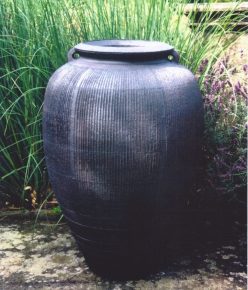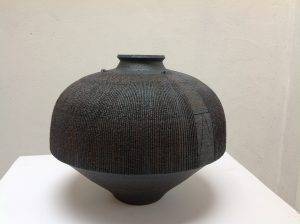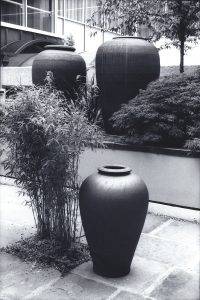JENIFER JONES, CERAMIC ARTIST
AN ESSAY by LUCY GENT
Each of Jenifer Jones’ pots is a unique presence. Her pots are imbued with a darkness that suggests they have not merely been fired in the potter’s kiln but rather burnt in some subterranean fire and rescued after long burial in the earth. Shades of deep plum, umber, sienna or black glint with the occasional lustre of metallic ore. Despite their apparent austerity, you nonetheless expect them to be warm to the touch.
Their impact is closely bound up with the manner of their making. Jenifer Jones uses a heavily grogged clay body – strong, warm in colour and rich in texture, the coarse granules of the grog strengthening and enriching the softness of the clay. Each vessel is built up on a turntable from thick coils of clay, each new coil pinched back into the existing wall as the shape rises. By this means the form of the pot is exceptionally felt as it emerges.
The surface is then scraped with a metal kidney both to refine the form and to reveal the texture of the body. At this stage too the walls may be gently beaten. This strengthens them and is also a means to make fine adjustments to the degree of symmetry or asymmetry of the form. Building these pots is necessarily a slow process -taking many weeks, even months for the very largest. For at each stage the clay wall must have time to dry and harden sufficiently to carry the weight of the growing pot. However minute the initial planning, therefore, there is time for many considered adjustments to the overall form as the final shape is slowly revealed.
When the form of the pot is completed, but the surface is still leather hard, the walls are incised with a small knife. This scoring throws the clay up into tiny parallel ridges reminiscent of the burr that marks the passage of the engraver’s burin across the plate. Often the circumference of the pot will be divided into a number of bays, for example six, each of which may be subdivided again proportionally according to the scale of the piece. This creates a rhythm that moves lightly around the whole form.
These incised lines – sometimes running vertically over the body of the pot sometimes grouped into sparer chevron or zigzag formations – are embedded in the surface to become part of the form itself. The lines enhance our awareness of the rounded sides, making them more tangible, engaging the eye insensibly in measuring and mapping contours, their insistent parallels closing up as they disappear out of sight round the sides.
In another way though, this scoring may appear like wires stretched out under tension, as if restraining the pressure of the walls to swell outwards, their vertical precision opposed to the equally precise horizontal banding. Rims are especially important in these pots. They both open the pot to the air and at the same time mark the completion of the form. Appropriately the rims are strong and precise.
In a garden landscape or in an architectural setting they are supremely sculptural forms, as the vast pots in the Queen Elizabeth Conference Centre show. Here the strong curve of the ample shoulder rising above acer leaves suggests the smooth round form of some Buddha-like figure fixed forever in the act of contemplation. Here too the pots’ rich textures recall the contrasted but always tranquil elements of a Japanese garden, and makes them peculiarly sympathetic to the textural qualities of plants.
A group of three large pots for the Queen Elizabeth II Conference Centre, Westminster.
Ultimately though each pot finds its final function not just in the scale and authority of the vessel but as an expressive presence, un-rhetorical yet strong. This unique presence, this quiet majesty, is the final resolution of the potter’s insistent pursuit of form.
Lucy Gent


